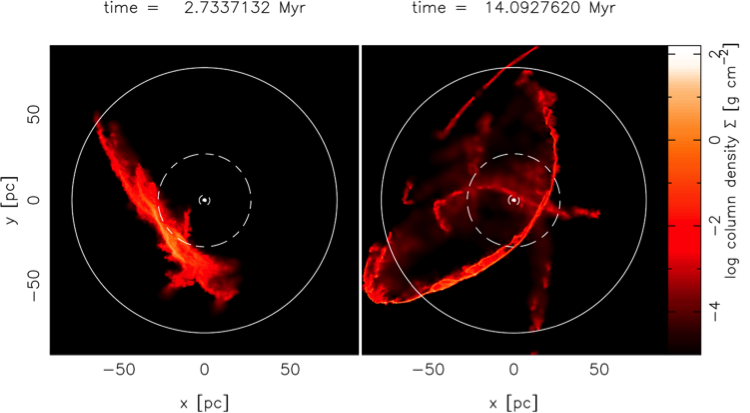

Simulations
Galactic scale models of star formation focus on resolving how large-scale gas flows in spiral galaxies form the dense gas clouds where star formation occurs on scales 10,000 times smaller. The rate at which stars form in galaxies appears to be linked to the global as well as local properties. Using DiRAC, we have performed the largest-scale numerical simulations that can resolve the dense regions where stars form, and hence directly study the physics that drives star formation. We are using these simulations to understand how star formation is initiated, and what determines the resulting properties including why it has such a low efficiency (∼1%).

Fig. 1 The dense gas formed from a spiral shock is viewed perpendicular to the plane of the galaxy.

Fig 2: A gas cloud moving on an eccentric orbit in the Galactic Centre is tidally sheared to form nearly complete stream.
In order to construct a full theory of star formation, we need to also include additional physics of magnetic fields and the radiative and kinetic feedback processes from young stars. Constructing these self-consistent models, akin to modelling a full galactic ecology, requires the ability to model 100 to 1000 million individual elements in the galaxy and can only be performed with the HPC resources provided through DiRAC.
DiRAC: Distributed Research utilising Advanced Computing
DiRAC is the integrated supercomputing facility for theoretical modelling and HPC-based research in particle physics, astronomy and cosmology, areas in which the UK is world-leading.
In 2009, the Science and Technology Facilities Council (STFC) received £12.32 million, from the Government's Large Facilities Capital Fund to invest in new hardware to provide UK particle physics and astronomers with upgraded HPC technology to address some of the most challenging scientific problems. In 2011, DiRAC received an additional £15 million from government (DiRAC II), together with a contribution towards operating costs from STFC.
DiRAC provides a variety of computer architectures, matching machine architecture to the algorithm design and requirements of the research problems to be solved. There are sound scientific reasons for this choice which was adopted as a philosophy following a number of in-depth reviews involving the research community which gave detailed advice on the nature and balance of resources required by the STFC research community. The demands of the different research domains supported by STFC are such that a distributed installation was the most cost effective way to satisfy the varied scientific requirements.
As a single Facility, DiRAC allows more effective and efficient use of equipment, promotes the science goals of the STFC communities, provides a common training and consultation framework and, crucially, provides critical mass and a coordinating structure for both small and large scale cross-discipline science projects, the technical support needed to run and develop a distributed HPC service, and potential knowledge transfer and industrial partnership projects. The continued pooling of complementary expertise will ensure that the UK remains one of the world-leaders of theoretical modelling in particle physics, astronomy and cosmology.
http://www.dirac.ac.uk/
